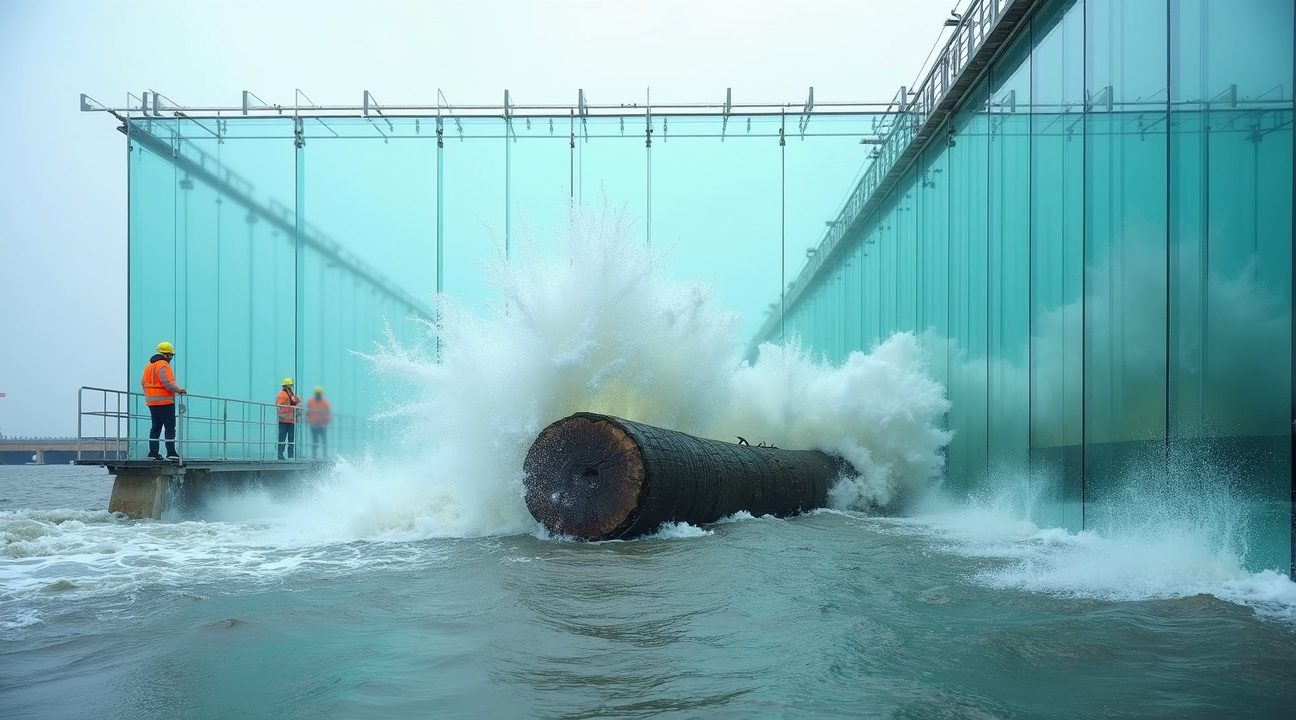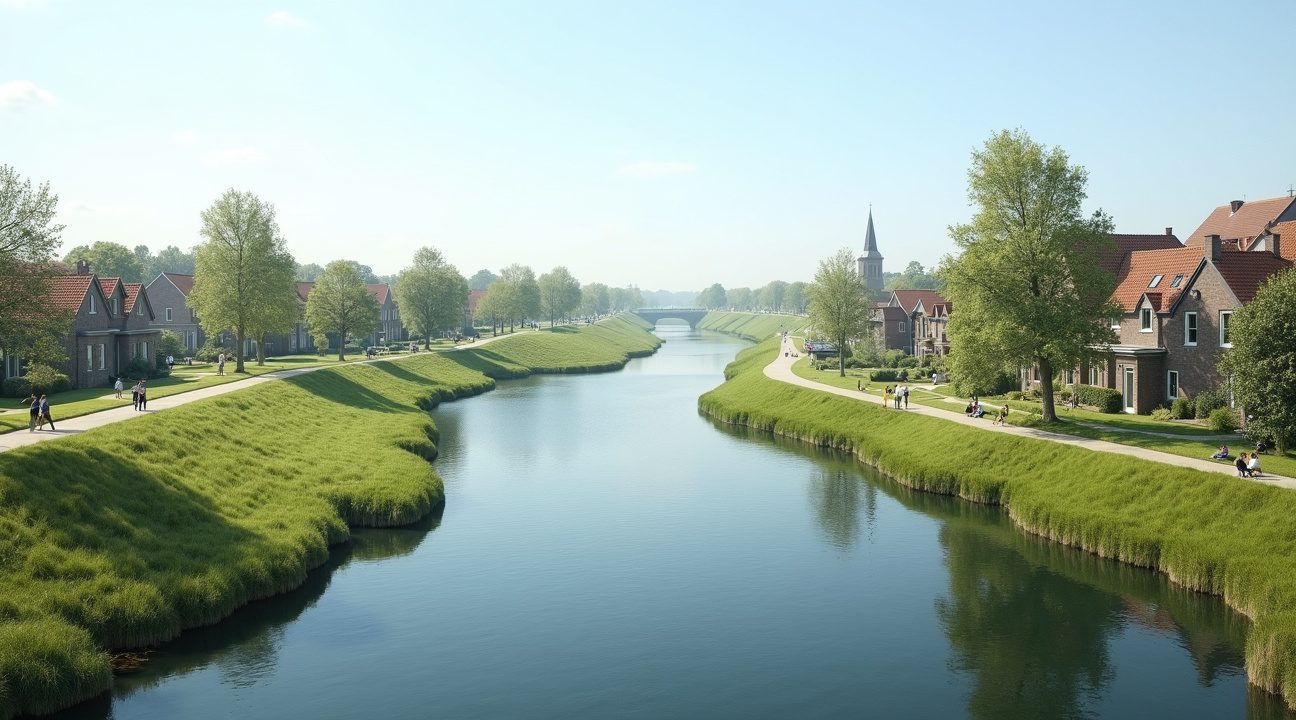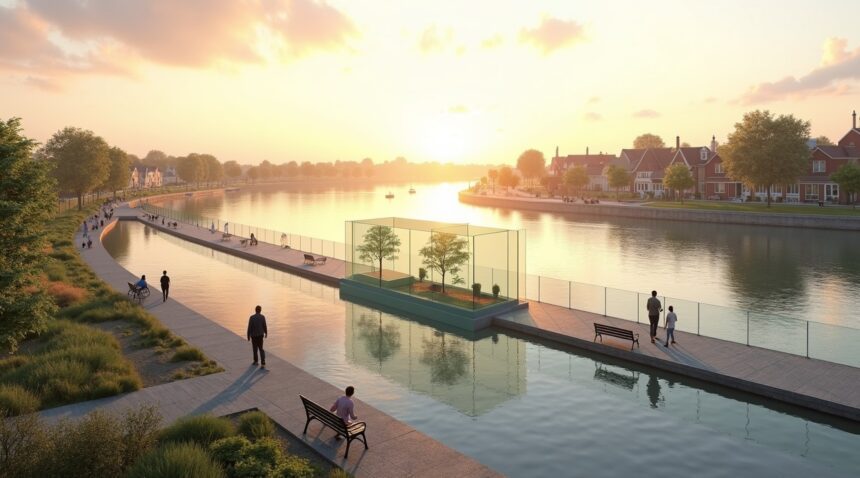The Netherlands has installed groundbreaking carved glass wave walls in the town of Neer that deliver complete flood protection while preserving residents’ valued river views and sunset vistas.
These transparent barriers represent a revolutionary shift from traditional concrete flood defenses, proving that communities no longer need to choose between safety and scenic beauty when protecting against deadly storms.
Key Takeaways
- Glass flood barriers spanning 80 meters across four locations in Neer combine multiple reinforced layers with sacrificial panels to withstand massive storm impacts while maintaining crystal-clear visibility.
- Rigorous testing at the Delta Flume facility proved the barriers can survive 800-kilogram tree trunks launched at high speed and repeated wave impacts up to 0.5 meters high.
- The comprehensive flood defense system includes 1,600 meters of green dikes, 550 meters of hard retaining walls, and strategically placed glass sections based on community input about preserving scenic views.
- Engineering specifications include three structural middle layers, two replaceable exterior panels, and 1.5mm protective films that resist salt spray, UV radiation, and temperature fluctuations over decades.
- This community-driven design approach demonstrates how modern flood protection can enhance rather than diminish waterfront living, offering a model for coastal cities worldwide facing rising seas and intensifying storms.
Revolutionary Glass Barriers Shield Dutch Town While Preserving River Views
The Netherlands has pioneered an extraordinary solution that fundamentally transforms flood protection by installing innovative glass barriers in Neer, Limburg. These transparent flood defenses successfully balance critical safety requirements with residents’ desire for unobstructed views, creating what authorities describe as achieving both safety and visibility for the local community.
Unlike traditional concrete or earthen flood barriers that block scenic vistas, these glass flood barriers maintain panoramic views of the Meuse river while providing essential protection against rising waters. Residents can still enjoy breathtaking sunsets and appreciate the natural beauty of their surroundings without sacrificing flood security. This groundbreaking approach represents a significant departure from conventional flood management strategies that often isolate communities from their waterfront environments.
Advanced Engineering Behind the Transparent Defense
The sophisticated structure of these glass barriers demonstrates remarkable engineering precision through multiple protective layers. Each barrier incorporates three reinforced structural middle layers that form the core strength of the system, ensuring the walls can withstand significant water pressure during flood events. Two sacrificial panels on the exterior provide additional protection and can be replaced if damaged, while 1.5 mm protective films between layers add another level of durability.
This layered glass panel design, developed in collaboration with Scheuten, a leading supplier of glass products, optimizes both visual transparency and structural integrity. The glass thickness and specific layering configuration have been precisely engineered to meet stringent safety standards while maintaining crystal-clear visibility. Engineers calculated the exact specifications needed to resist flood forces while preserving the aesthetic qualities that make these barriers truly revolutionary.
Impressive Scale and Strategic Implementation
The total glass wall installation spans an impressive 80 meters across four strategic locations throughout Neer, with the longest single segment measuring 30 meters. This substantial coverage ensures comprehensive protection for the community while maintaining consistent visual access to the river landscape. The Herik/Strukton consortium managed the complex installation process, coordinating with Waterschap Limburg to integrate these barriers seamlessly into existing flood management infrastructure.
Each segment was carefully positioned to maximize both protective coverage and scenic preservation, creating an uninterrupted shield against potential flooding. The strategic placement allows residents to maintain their connection to the river environment that defines their community’s character. These installations represent the future of flood defense technology, proving that safety and beauty can coexist effectively.
The success of this dike reinforcement project demonstrates how innovative thinking can solve traditional infrastructure challenges. Rather than forcing communities to choose between protection and quality of life, these transparent flood defenses offer both benefits simultaneously. The glass barriers have already proven their effectiveness during recent high-water events, providing reliable protection while residents continue enjoying their river views.
This pioneering approach to flood management could influence future infrastructure projects throughout flood-prone regions. The combination of advanced materials science and thoughtful design creates a template for communities facing similar challenges between safety and environmental connection. The Neer installation proves that cutting-edge solutions can preserve both human safety and community character.
The Netherlands continues leading global innovation in flood management through projects like these glass barriers. Communities worldwide facing rising sea levels and increased flood risks can look to this example as proof that protective infrastructure doesn’t require sacrificing the natural beauty that makes waterfront living desirable. These transparent barriers represent a new paradigm where safety and scenery enhance each other rather than compete.
Extreme Testing Proves Glass Walls Can Survive Nature’s Worst
Before the Netherlands could install these revolutionary glass barriers along its vulnerable coastlines, engineers needed absolute certainty that their transparent storm shields could withstand the ocean’s most devastating forces. The answer came through intensive real-world testing at the Deltares’ Delta Flume in Delft, where researchers put the glass walls through conditions that would destroy conventional barriers.
Surviving Massive Impact Forces
The testing facility subjected a full-scale section of the glass barrier to scenarios that mimic nature’s most destructive moments. Engineers watched as waves reaching 0.5 meters high crashed repeatedly against the transparent surface, simulating the kind of storm surge that has historically breached traditional sea walls. However, the most dramatic test involved launching a massive 6-meter-long tree trunk weighing 800 kilograms directly at the barrier.
This wasn’t a gentle tap – the 40-centimeter-diameter projectile struck the glass at 2 meters per second, delivering the kind of devastating blow that floating debris creates during severe storms. The impact-resistant glass held firm, proving that even when hurricanes and storm surges hurl massive objects at these barriers, communities remain protected. Such testing reflects the harsh reality of coastal defense, where storms don’t just bring water but transform everyday objects into dangerous projectiles.
Official Approval and Long-term Durability
The rigorous testing caught the attention of the Flood Risk Management Expertise Network (ENW), which reviewed every aspect of the barrier’s performance before granting official approval. This endorsement carries significant weight, as the ENW sets the safety standards that protect millions of Dutch residents living below sea level. Their approval process involves scrutinizing not just immediate performance but also how materials will respond to decades of exposure to salt spray, UV radiation, and temperature fluctuations.
Engineers optimized both the glass composition and the specialized interlayer films that bind multiple glass sheets together. These interlayers serve a dual purpose – they maintain structural integrity even if the outer glass cracks, and they resist degradation from constant weather exposure. The result is a barrier system that maintains its protective capabilities year after year while preserving the crystal-clear views that make these installations so remarkable.
The Delta Flume testing revealed something extraordinary about modern engineering capabilities. Traditional concrete sea walls require massive thickness to absorb impact energy, but these glass barriers achieve superior protection through advanced materials science. The transparent design doesn’t compromise safety – it enhances it by allowing coastal communities to maintain visual connection with the sea while staying completely protected from its dangers.
Safety standards for coastal defense have evolved dramatically as climate change intensifies storm patterns. The approval process now considers not just current weather conditions but projected increases in storm intensity over the coming decades. The glass barriers passed these forward-looking assessments, demonstrating that they can protect communities even as coastal threats continue to escalate.
This testing program established new benchmarks for what’s possible in coastal defense technology. The combination of transparency and strength creates opportunities for waterfront development that were previously impossible. Communities can now build closer to the water while maintaining safety levels that exceed traditional protection methods. The success at the Delta Flume proves that innovative materials can solve problems that seemed impossible just decades ago, offering hope for coastal cities worldwide facing similar challenges from rising seas and intensifying storms.

Community-Driven Design Balances Protection with Quality of Life
The Netherlands’ innovative approach to flood protection in Neer demonstrates how engineering solutions can honor both safety requirements and community preferences. Rather than implementing traditional concrete barriers that would have blocked cherished river views, Dutch engineers engaged directly with local residents to understand their priorities and concerns about living alongside flood defenses.
Preserving Scenic Beauty Through Transparent Solutions
The extensive consultation process revealed that maintaining visual connections to the landscape was essential for riverside residents’ quality of life. Community members expressed strong concerns about losing their scenic river views to imposing concrete structures. This feedback directly influenced the decision to incorporate carved glass walls in strategic locations where visibility mattered most to the local population.
The comprehensive flood defense system spans an impressive scope, including:
- Approximately 1,600 meters of strengthened green dikes that blend naturally with the landscape
- 550 meters of hard retaining walls for maximum structural protection
- Strategic placement of transparent glass barriers where aesthetic considerations take priority
- Careful integration of different barrier types based on specific location requirements
Installation of these innovative flood defenses began in autumn 2020, with the entire project reaching completion by late 2020. The timeline reflects the urgency of climate adaptation needs while allowing sufficient time for proper community consultation and careful implementation of the technical specifications.
This selective approach to barrier placement shows sophisticated planning that considers both hydraulic engineering requirements and human factors. Green dikes provide effective protection while maintaining natural aesthetics in most areas, while the hard retaining walls offer maximum security where structural demands are highest. The glass barriers serve as the premium solution for locations where residents specifically requested unobstructed views.
The Neer project represents a significant shift in flood management philosophy, moving away from one-size-fits-all solutions toward community-responsive designs. Local input shaped not just the final appearance but also the fundamental approach to balancing protection with livability. This methodology ensures that flood defenses enhance rather than diminish the residential experience along the river.
The success of this community-driven design process offers valuable lessons for coastal and riverine communities worldwide facing similar challenges. By prioritizing dialogue with affected residents from the project’s earliest stages, Dutch engineers created a flood defense system that residents can embrace rather than merely tolerate. The transparent glass sections allow families to maintain their connection to the water while feeling secure about their protection from extreme weather events.
The dike modernization project in Neer showcases how advanced materials and thoughtful planning can resolve the traditional conflict between safety and aesthetics in flood management. The carved glass walls represent more than just a technical achievement—they embody a commitment to preserving the quality of life that draws people to waterfront communities in the first place.
This approach recognizes that effective flood protection must consider the full spectrum of community needs, not just hydraulic performance metrics. The result is a flood defense system that residents view as an asset rather than an obstruction, creating a model for future coastal protection projects facing similar challenges between safety and scenic preservation.

How Glass Walls Compare to the Netherlands’ Massive Delta Works
The contrast between traditional Dutch flood defenses and modern glass barriers reveals a fundamental shift in engineering philosophy. I’ve observed how these two approaches represent different eras of water management, each reflecting the priorities and capabilities of their time.
Scale and Power of Traditional Defenses
The Maeslant Barrier stands as perhaps the most impressive example of traditional Dutch engineering might. This massive structure features two gates, each measuring 210 meters wide and 22 meters high, with each gate weighing as much as the Eiffel Tower. When I consider the sheer scale of these engineering marvels, the numbers tell a story of human determination against nature’s forces.
The broader Delta Works project, which includes the Maeslant Barrier, represents an investment of approximately $7 billion over 43 years of construction. These defenses protect against storm surges expected once every 4,000 years, demonstrating the Dutch commitment to long-term safety. The emphasis here lies squarely on strength and reliability through massive physical presence.
Traditional barriers like these prioritize function over form, creating imposing walls between communities and their waterfront environments. While undeniably effective, they often block views and create psychological barriers between residents and the sea that defines Dutch coastal life.
Modern Integration and Visibility
Glass flood barriers represent a completely different engineering philosophy that emerged in the 21st century. These structures maintain the same protective standards while transforming the relationship between safety infrastructure and daily life. I find their approach particularly compelling because they solve the age-old problem of protection versus livability.
The key advantages of glass barriers include:
- Preservation of sea views and natural light during normal conditions
- Maintenance of psychological connection to waterfront environments
- Integration with urban design and community spaces
- Reduced visual impact on coastal landscapes
- Enhanced property values through maintained vistas
These modern defenses embody adaptable engineering principles that respond to both environmental threats and human needs. Rather than creating fortress-like barriers, they function as transparent shields that activate only during storm conditions. This approach reflects growing awareness that flood protection must coexist with quality of life considerations.
The glass walls demonstrate how Dutch water engineering has evolved beyond pure functionality. They represent a synthesis of protection and preservation, acknowledging that effective flood defense shouldn’t require communities to sacrifice their connection to the sea. This philosophy aligns with broader trends in sustainable urban planning where infrastructure serves multiple purposes.
Both approaches share the same fundamental Dutch commitment to water safety, yet they represent dramatically different solutions to similar challenges. The Delta Works proved that monumental engineering could protect entire regions, while glass barriers show that protection can enhance rather than diminish community life. Together, they illustrate the evolution of Dutch flood defense from purely protective structures to integrated urban amenities that maintain safety without compromising livability.
This progression reflects broader changes in engineering priorities, where sustainability, community impact, and environmental integration have become equally important as technical performance. The success of both approaches demonstrates that Dutch water management continues to set global standards, whether through impressive scale or innovative integration.
To see the Maeslant Barrier in operation, view this YouTube video:
https://www.youtube.com/watch?v=sbX_pFfOHJg
The Future of Smart Flood Defense in a Changing Climate
Climate change demands revolutionary approaches to flood protection, and the Netherlands stands at the forefront of this transformation. Rising sea levels and intensifying storms challenge traditional flood barriers, pushing engineers to develop innovative solutions that protect communities while preserving quality of life.
Next-Generation Storm Surge Technologies
Dutch researchers actively develop advanced materials and smart technologies to upgrade aging flood infrastructure. These innovations respond directly to accelerating sea level rise and shifting weather patterns that make traditional concrete barriers insufficient. Smart sensors now monitor water levels in real-time, while adaptive materials can adjust their properties based on storm conditions.
The integration of climate adaptation strategies into flood protection creates systems that learn and evolve. Engineers incorporate predictive algorithms that anticipate storm patterns, allowing barriers to prepare automatically for incoming weather events. This proactive approach marks a significant departure from reactive flood management of the past.
Living with Water Philosophy
Modern Dutch water management embraces the concept of living with water rather than fighting against it. Projects like those in communities such as innovative urban planning demonstrate how flood protection can enhance rather than diminish community spaces. Glass flood walls exemplify this philosophy by maintaining visual connections to waterfront environments while providing essential storm protection.
Community-focused planning ensures that flood defenses serve multiple purposes:
- Parks double as water retention areas
- Elevated walkways provide both flood evacuation routes and recreational spaces
- Public spaces remain accessible and scenic
This multifunctional approach maximizes the value of infrastructure investments while building community resilience.
Ecological design principles guide new flood protection projects, creating barriers that support biodiversity while defending against storms. Green infrastructure elements like living shorelines and constructed wetlands work alongside technological solutions to create comprehensive defense systems.
These hybrid approaches prove more effective than single-solution strategies.
Sustainable flood protection now incorporates renewable energy generation, with solar panels and wind turbines integrated into barrier designs. Dutch innovation continues to push boundaries by developing self-powered flood defense systems that contribute to national energy goals while protecting coastlines.
The evolution from simple dikes to intelligent, adaptive flood management systems reflects the Netherlands’ commitment to long-term climate resilience. Future barriers will respond dynamically to changing conditions, protecting communities while maintaining the connection between people and water that defines Dutch coastal culture.
Sources:
PreventionWeb – Netherlands: Unique test of flood barrier made of glass
Rijkswaterstaat – Maeslant Barrier
AVEVA – How the Netherlands Became the Global Leader in Flood Defense
NWO (Dutch Research Council) – Research: how storm surge barriers can keep the Netherlands safe and liveable


